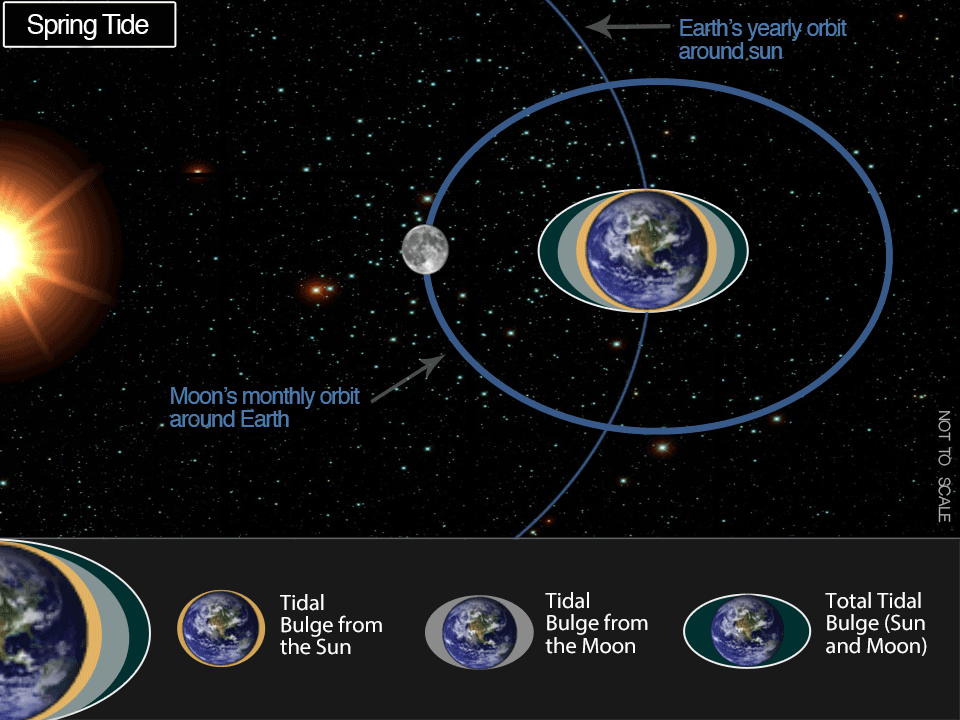Citation: Kemp, A.C., Shaw, T.A., and Piecuch, C.G., 2022, The importance of non-tidal water-level variability for reconstructing Holocene relative sea level: Quaternary Science Reviews 290: 107637. https://doi.org/10.1016/j.quascirev.2022.107637
It is well known that tides vary greatly by location. Along the Atlantic coast of the United States tidal ranges are no exception and fluctuate from 0.30 meters (0.98 ft) at Vaca Key, Florida up to 5.9 meters (19.36 ft) at Eastport, Maine. While it might seem like areas with larger tidal ranges would be more likely to flood, this is not always the case. Instead, in some regions several factors other than tides might actually have a larger effect on the water level. If these non-tidal influences are not properly taken into consideration, they can lead to incorrect estimates of flooding potentials and reconstructions of past sea-levels.
What Are Tides?
Tides are the regular rise and fall of the sea surface level relative to the coast resulting mainly from the gravitational pull of the moon and the rotation of the Earth. The gravitational pull of the moon causes the water to “bulge” both on the side of the Earth closest to the moon as well as on the side furthest away from it. This effect is referred to as the tidal force. The rotation of the Earth then causes different parts of the world to rotate into and out of these bulges, creating high tide and low tide. High tide in a given area falls when the water reaches its highest point on the shoreline, while low tide occurs when the water recedes to its furthest point away from the coast. The difference in the height of the sea surface between high tide and low tide is known as the tidal range.
Tides are also influenced to a lesser extent by the gravitational pull of the sun. When the Earth, moon, and sun are aligned during a full moon or a new moon, the gravitational pulls of the moon and the sun can be combined to create more extreme tides, known as spring tides. The two gravitational pulls can also act against each other when the moon is at a right angle to the sun, resulting in smaller tides known as neap tides.

It comes as no surprise that all of these tides affect water levels around the world. Due to their regular occurrences, it is possible to predict the changes in sea surface height due to tidal processes at a given location. However, these predictions do not account for changes in the sea surface height that originate from non-tidal forces, including meteorological (wind, air pressure), hydrologic (evaporation, precipitation), and oceanographic (ocean currents) processes.
Can We Determine the Influence of Non-Tidal Processes on Sea Level?
In their study, Kemp et al. (2022) looked at tide gauge measurements and predictions of water levels for 43 locations along the Atlantic coast of the United States. They determined that the predicted water levels included only the influences of tides on the water level, while the measured water levels from the tide gauges reflected the outcomes of all processes (both tidal and non-tidal) that influenced the water level at each site. The researchers then estimated the influence of only the non-tidal processes on the water levels by looking at the difference between the measured and predicted water levels at each location. In order to compare the relative influences of tidal and non-tidal processes on water levels across the entire Atlantic coast, they then converted the water levels into a “tidal ratio.” If the tidal ratio at a site was equal to 1, the observed water level change was only from tides. If the tidal ratio at a site was less than 1, the water level was also influenced by non-tidal processes.
The researchers found that at sites with large tidal ranges, non-tidal processes had a smaller influence on local water levels. This result is due to the smaller non-tidal variability being “absorbed” by the significantly larger tidal-driven water level changes. In contrast, in areas with smaller tidal ranges, non-tidal processes can influence water levels, but only if the magnitudes of the tidal and non-tidal variations are similar. These conclusions meant that at places with large tidal ranges, such as the Gulf of Maine, reconstructions of past sea levels may have been underestimated. On the other hand, in microtidal regions, such as the Chesapeake Bay, sea level reconstructions may have overestimated the amount of change.
So What Does This All Mean?
Local water levels are influenced by a variety of factors, including in many areas both a combination of tidal and non-tidal processes. It is important to assess the relative influence of each of these processes when considering past and future water level changes. As many sea-level predictions only account for tidal contributions to water level changes, flooding estimates and past sea-level reconstructions might not be as accurate as once believed.
Featured image from Des Blenkinsopp on Wikimedia Commons.

I am a Ph.D. candidate in Marine Geosciences at the Leon H. Charney School of Marine Sciences, University of Haifa. My research focuses on sea-level rise and coastline changes, specifically identifying geomorphological and sedimentological indicators of past sea-levels along the Mediterranean coast of Israel. In my free time, I enjoy scuba diving, traveling, and reading.

